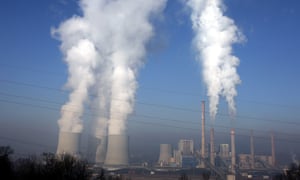Latest data shows steep rises in CO2 for seventh year
Readings from Hawaii observatory bring threshold of 450ppm closer sooner than had been anticipated

The concentration of carbon dioxide in the atmosphere has increased by the second highest annual rise in the past six decades, according to new data.
Atmospheric concentrations of the greenhouse gas were 414.8 parts per million in May, which was 3.5ppm higher than the same time last year, according to readings from the Mauna Loa observatory in Hawaii, where carbon dioxide has been monitored continuously since 1958.
Scientists have warned for more than a decade that concentrations of more than 450ppm risk triggering extreme weather events and temperature rises as high as 2C, beyond which the effects of global heating are likely to become catastrophic and irreversible.
May is the most significant month for global carbon dioxide concentrations because it is the peak value for the year, before the growth of vegetation in the northern hemisphere starts to absorb the gas from the air. The seasonal peak and fall can be seen in the Keeling curve, named after Charles Keeling, who started the observations on Mauna Loa because of its isolation in the Pacific Ocean.
This is the seventh consecutive year in which steep increases in ppm have been recorded, well above the previous average, and the fifth year since the 400ppm threshold was breached in 2014. In 2016, the highest annual jump in the series so far was recorded, from 404.1 in 2015 to 407.66 in 2016.
As recently as the 1990s, the average annual growth rate was about 1.5ppm, but in the past decade that has accelerated to 2.2ppm, and is now even higher. This brings the threshold of 450ppm closer sooner than had been anticipated. Concentrations of the gas have increased every year, reflecting our burning of fossil fuels.
Ralph Keeling of the Scripps Institute, and the son of Charles, said: “The CO2 growth rate is still very high – the increase from last May was well above the average for the past decade.” He pointed to the mild El Niño conditions experienced this year as a possible factor.
Tuesday’s findings come from Mauna Loa and the US National Oceanic and Atmospheric Administration, which has also made complementary independent measurements of greenhouse gas concentrations since the 1970s. NOAA’s Barrow observatory on Alaska’s North Slope showed an average of 417.4ppm over the period, but the Arctic typically has higher CO2 readings than the Mauna Loa series.
Pieter Tans, a senior scientist at NOAA, said: “It is critically important to have these accurate long-term measurements of CO2 in order to understand how quickly fossil fuels are changing our climate. These are measurements of the real atmosphere, and do not depend on any models, but they help us verify climate model projections, which if anything have underestimated the rapid pace of climate change being observed.”
As the crisis escalates…
… in our natural world, we refuse to turn away from the climate catastrophe and species extinction. For The Guardian, reporting on the environment is a priority. We give reporting on climate, nature and pollution the prominence it deserves, stories which often go unreported by others in the media. At this pivotal time for our species and our planet, we are determined to inform readers about threats, consequences and solutions based on scientific facts, not political prejudice or business interests.
More people are reading and supporting The Guardian’s independent, investigative journalism than ever before. And unlike many news organisations, we have chosen an approach that allows us to keep our journalism accessible to all, regardless of where they live or what they can afford. But we need your ongoing support to keep working as we do.
The Guardian will engage with the most critical issues of our time – from the escalating climate catastrophe to widespread inequality to the influence of big tech on our lives. At a time when factual information is a necessity, we believe that each of us, around the world, deserves access to accurate reporting with integrity at its heart.
Our editorial independence means we set our own agenda and voice our own opinions. Guardian journalism is free from commercial and political bias and not influenced by billionaire owners or shareholders. This means we can give a voice to those less heard, explore where others turn away, and rigorously challenge those in power.
We need your support to keep delivering quality journalism, to maintain our openness and to protect our precious independence. Every reader contribution, big or small, is so valuable. Support The Guardian from as little as CA$1 – and it only takes a minute. Thank you.

No comments:
Post a Comment